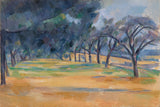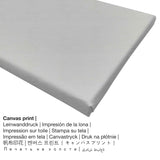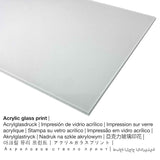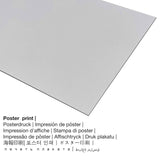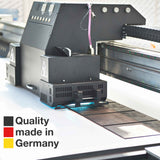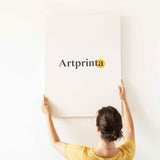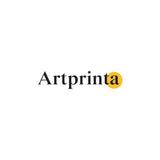Paul Cézanne, 1898 - The Alley at Marines (Alley of Marines) - ọmarịcha nka.
Ụtụ gụnyere. Mbupu gbakọrọ na ndenye ọpụpụ.
Nchịkọta nke ngwaahịa ebipụta
E kere ihe nka Paul Cézanne n’afọ 1898. Ihe kariri 120 afọ mbụ tụrụ nha: N'ozuzu: 25 3/4 × 38 3/4 na (65,4 × 98,4 cm). Mmanụ na kwaaji was used by the European artist as the medium of the artwork. This work of art can be viewed in in the digital collection of Barnes Foundation, which home to one of the world's greatest collections of impressionist, post-impressionist and early modernist paintings. This ngalaba ọha artpiece is supplied with courtesy of Courtesy of the Barnes Foundation, Merion and Philadelphia, Pennsylvania.The creditline of the artwork is: . In addition to that, the alignment is in odida obodo usoro na nwere akụkụ ruru nke 3: 2, which means that the length is 50% longer than the width. The painter Paul Cézanne was a European artist from France, whose artistic style can be attributed primarily to Impressionism. The European painter lived for 67 years and was born in the year 1839 and passed away in 1906.
Data nka ahaziri
| Aha nka nka: | "The Alley at Marines (Alley of Marines)" |
| Nhazi nka: | sere |
| Okwu mkpokọta: | nkà nke oge a |
| Nhazi oge: | 19th narị afọ |
| Emepụtara na: | 1898 |
| Afọ nka: | ihe karịrị afọ 120 |
| Ọkara nke ihe osise izizi: | mmanụ na kwaaji |
| Nha izizi (ọrụ nka): | N'ozuzu: 25 3/4 × 38 3/4 na (65,4 × 98,4 cm) |
| Egosiputara na: | Ntọala Barnes |
| Ebe ngosi nka: | Philadelphia, Pennsylvania, Njikota Obodo Amerika |
| Weebụsaịtị nke ihe ngosi nka: | Ntọala Barnes |
| Ụdị ikike nka: | ngalaba ọha |
| Site n'aka: | Site n'ikike nke Barnes Foundation, Merion na Philadelphia, Pennsylvania |
Tebụl nchịkọta ihe nkiri
| Aha onye nka: | Paul Cézanne |
| okike nke onye nka: | nwoke |
| Obodo onye nka: | French |
| Ọrụ: | onye na-ese ihe |
| Obodo obibi: | France |
| Otu nka: | omenkà nke oge a |
| Ụdị nka: | Mmetụta |
| Oge ndu: | 67 afọ |
| Afọ ọmụmụ: | 1839 |
| Afọ nwụrụ: | 1906 |
| Ebe ọnwụ: | Aix na Provence |
Nhọrọ akụrụngwa enwere ike
The product dropdown menu ofers you the possibility to choose the size and materialaccording to your preferences. The following sizes and materials are the options we offer you for individualization:
- Akwụkwọ mmado na ihe kwaaji: The poster print is a UV printed canvas paper with a slightly rough texture on the surface, which resembles the original work of art. Please keep in mind, that depending on the size of the canvas poster print we add a white margin 2-6cm round about the artwork, which facilitates the framing with a custom frame.
- Aluminom dibond (ọkpụkpụ ọla): This is a metal print manufactured on aluminium dibond material with an outstanding effect of depth. A direct Aluminium Dibond Print is the perfect introduction to fine art prints made on aluminum. For your Direct Print On Aluminum Dibond, we print the selected artpiece on the surface of the white-primed aluminum.
- Mbipụta kanvas: The UV printed canvas material mounted on a wood stretcher frame. The canvas makes a charming and appealing effect. A canvas print of this artwork will allow you to transform your fine art print into a large collection piece as you would see in a gallery. The great advantage of canvas prints is that they are relatively low in weight, meaning that it is easy to hang your Canvas print without extra wall-mounts. Therefore, a canvas print is suitable for any type of wall.
- Glass acrylic ebipụtara (nke nwere ezigbo mkpuchi iko n'elu): The acrylic glass print, often denoted as a print on plexiglass, transforms an artwork into lovely décor. Your favorite artwork is printed thanks to the help of state-of-the-art UV direct printing technology. With an acrylic glass fine art print sharp contrasts plus minor details become more visible due to the precise tonal gradation of the picture. Our acrylic glass protects your selected art replica against light and heat for many years.
Nkọwapụta ngwaahịa
| Bipụta ngwaahịa: | ọrụ mgbidi |
| Mmeputakwa: | dijitalụ mmeputakwa |
| Usoro mmepụta: | Mbipụta UV ozugbo |
| Mmalite nke ngwaahịa a: | arụpụtara na Germany |
| Ụdị ngwaahịa: | na mmepụta ihe |
| Eji ngwaahịa a chọrọ: | mgbidi gallery, mgbidi ndozi |
| Ndepụta: | nhazi odida obodo |
| Ụdị anya: | 3: 2 |
| Ntụgharị nkọwa akụkụ akụkụ: | ogologo bụ 50% ogologo karịa obosara |
| Nhọrọ akụrụngwa: | Mbipụta kwaaji, mbipụta enyo acrylic (nwere ezigbo mkpuchi iko), mbipụta akwụkwọ mmado (akwụkwọ kwaaji), mbipụta ọla (aluminium dibbond) |
| Mpempe akwa akwa (akwa akwa na etiti ihe ndọtị) nha: | 30x20cm - 12x8", 60x40cm - 24x16", 90x60cm - 35x24", 120x80cm - 47x31", 150x100cm - 59x39" |
| Mpempe iko acrylic (nwere ezigbo mkpuchi iko) nha: | 30x20cm - 12x8", 60x40cm - 24x16", 90x60cm - 35x24", 120x80cm - 47x31" |
| Mbipụta akwụkwọ mmado (akwụkwọ kwaaji): | 60x40cm - 24x16", 90x60cm - 35x24", 120x80cm - 47x31" |
| Nhọrọ nha nha nke aluminom dibond (ihe aluminom): | 30x20cm - 12x8", 60x40cm - 24x16", 90x60cm - 35x24", 120x80cm - 47x31" |
| Nhazi nke nka nka: | agunyeghi |
Nkwupụta iwu: We try all that we can in order to depict our art products with as many details as possible and to display them visually on the product detail pages. Although, the colors of the printed materials and the print result might vary slightly from the image on your device's screen. Depending on your screen settings and the quality of the surface, color pigments might not be printed one hundret percent realistically. Given that all the fine art prints are processed and printed manually, there might also be minor deviations in the exact position and the size of the motif.
© Nwebiisinka nke, Artprinta.com

